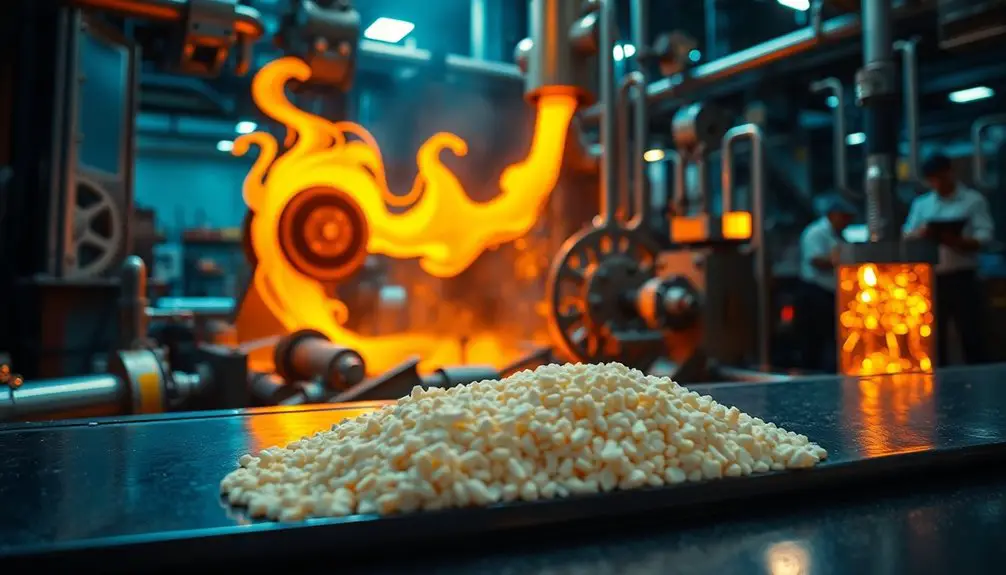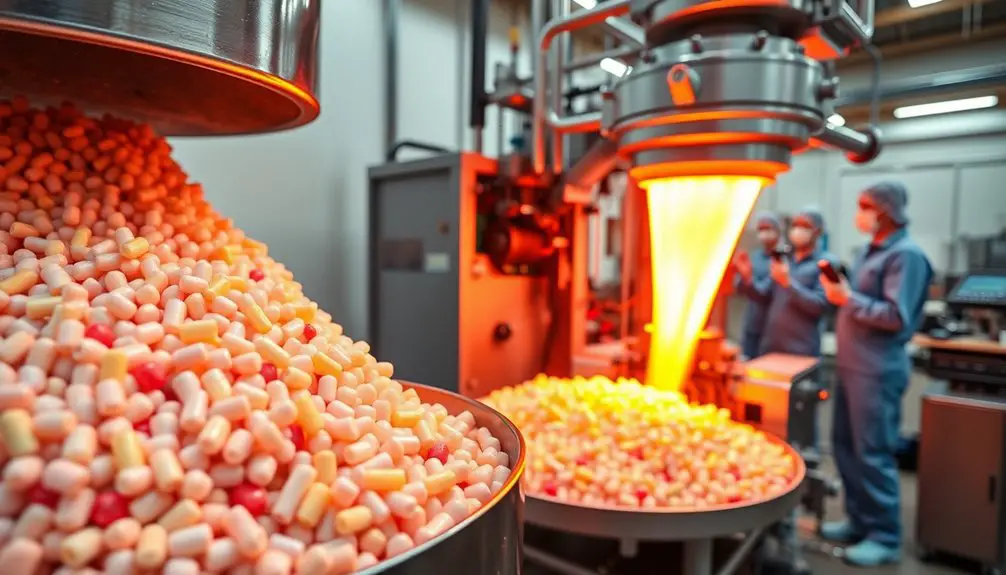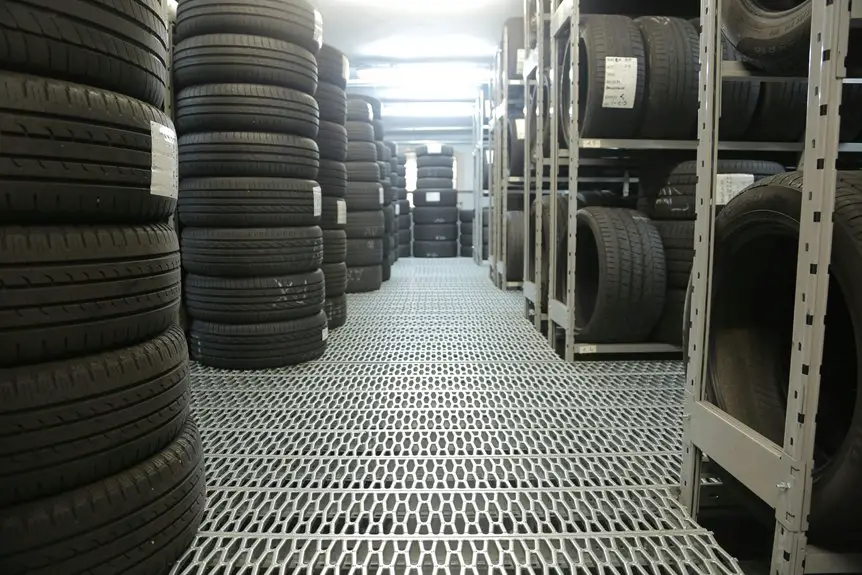You make polypropylene products by transforming propylene gas through a process called polymerization. First, you purify the propylene to remove impurities, then use catalysts like Ziegler-Natta or metallocene to control the molecular structure. Depending on the method—gas-phase, bulk, or solution—polypropylene can take different forms, either homopolymers or copolymers, each tailored for specific uses. Injection molding often shapes these materials for various applications, from automotive parts to packaging. Quality control measures ensure consistency and durability throughout production. There's much more to explore about this fascinating process and its wide-ranging applications, so keep going for more insights.
Key Takeaways
- Polypropylene production starts with purifying propylene gas, a byproduct of petroleum refining, to ensure high-quality input materials.
- The polymerization process, utilizing catalysts like Ziegler-Natta or metallocene, determines the molecular structure of the polypropylene.
- Gas-phase polymerization occurs under controlled temperatures (70°C to 100°C) and pressures (1 to 20 atm) to manage material properties.
- Customization during production enhances specific characteristics such as UV resistance, strength, and flexibility for various applications.
- Rigorous quality control, including melt flow index and tensile strength tests, ensures consistency and durability in final polypropylene products.
Overview of Polypropylene
Polypropylene, often referred to as PP, is a versatile thermoplastic polymer that's become a staple in modern manufacturing. First commercialized in 1957, it's the second most manufactured plastic globally, following polyethylene. PP is created through the polymerization of propylene gas, resulting in a material that boasts high chemical resistance and low moisture absorption. With a melting point around 160°C, it's suitable for a wide range of applications, from food packaging to automotive parts.
One of the key characteristics of polypropylene is its lightweight nature, with a density of less than 1 g/ml. This makes it ideal for products requiring strength without added weight, such as living hinges and medical devices. Its excellent fatigue resistance further enhances its appeal across various industries.
Polypropylene can also be customized by adding fillers and reinforcements, leading to different grades tailored for specific uses. For instance, rigid homopolymer is perfect for automotive applications, while flexible copolymer suits flexible containers.
Additionally, classified under recycling code #5, polypropylene is recyclable, with ongoing innovations aimed at improving its recycling processes and reducing its environmental footprint, ensuring its versatility continues for years to come. Furthermore, consumers play a crucial role in polypropylene recycling by properly sorting plastic recycling codes and reducing contamination in recycling streams.
Raw Materials and Preparation
The production of polypropylene starts with propylene gas, a crucial byproduct of petroleum refining. Before it can be used, this raw material undergoes purification to eliminate impurities that could affect the final product.
Once purified, it's ready for the polymerization process, where a catalyst system, such as Ziegler-Natta or metallocene, comes into play. This system is essential for controlling the molecular structure and properties of polypropylene.
The manufacturing typically employs methods like gas-phase polymerization, bulk polymerization, or solution polymerization. Each method influences the characteristics of the final polypropylene product.
For instance, gas-phase polymerization operates at temperatures between 70°C and 100°C, under pressures of 1-20 atm, ensuring optimal conditions for creating high-quality polymers.
The resulting polypropylene can take different forms, producing either a homopolymer or copolymer grade. These variations are specifically tailored for diverse applications by adjusting their mechanical and thermal properties.
Polymerization Process

Utilizing catalysts like Ziegler-Natta or metallocene, the polymerization process transforms propylene gas into polypropylene. This transformation is essential for producing different grades of polypropylene, which can include homopolymer and copolymer types.
The process typically occurs through gas-phase polymerization, where specific parameters are crucial for achieving desired outcomes.
- Temperature: Usually maintained between 70°C to 100°C.
- Pressure: Operates within a range of 1 to 20 atm.
- Catalysts: Ziegler-Natta and metallocene play vital roles in controlling the polymer's molecular structure.
Customization and Applications
After the polymerization process, polypropylene becomes a versatile material that can be tailored for a wide range of applications. Its customization options allow you to enhance properties like UV resistance or strength by adding fillers, colorants, and reinforcements. This adaptability is crucial across various sectors. The manufacturing process often utilizes injection molding, which is perfect for producing high volumes of complex shapes efficiently. Various grades of polypropylene, such as rigid homopolymer for automotive parts and flexible copolymer for living hinges, cater to specific needs. As the world shifts towards a more circular economy, manufacturers are incorporating biodegradable and recyclable materials, including bioplastics alternatives, to minimize environmental impact. Here's a quick overview of polypropylene's applications:
| Application | Characteristics |
|---|---|
| Automotive | Lightweight, durable, chemical-resistant |
| Packaging | Flexible, customizable, recyclable |
| Textiles | Durable, versatile designs |
| Medical Devices | Chemical resistance, sterile options |
| Consumer Goods | Custom colors, shapes, and strengths |
Innovations in recycling techniques and manufacturing processes, like metallocene catalysis, further enhance the capabilities of polypropylene, making it a sustainable choice for the future. Whether you're in automotive, packaging, or textiles, polypropylene's versatility meets your diverse needs.
Quality Control Measures

Ensuring high-quality polypropylene products hinges on rigorous quality control measures throughout the manufacturing process.
By implementing effective testing methods, manufacturers can guarantee that their products meet industry standards. Here are some crucial aspects of quality control:
- Melt flow index analysis to assess viscosity and processing characteristics.
- Tensile strength tests to ensure durability, typically around 4500 psi for homopolymer grades.
- Impact resistance evaluations to check material toughness for resilience against sudden forces.
Advanced techniques, such as spectroscopy and chromatography, play a significant role in confirming material purity.
This ensures that harmful impurities don't compromise the final product.
Additionally, consistency in production processes is vital; monitoring key parameters like temperature and pressure during polymerization directly influences product quality.
Frequently Asked Questions
What Is the Manufacturing Process of Polypropylene?
You'll find that polypropylene manufacturing involves polymerizing propylene gas using specific catalysts. This process, often done through gas-phase polymerization, allows you to create various grades of polypropylene tailored for different applications and quality standards.
What Products Are Made From Polypropylene?
You'll find polypropylene in everyday items like food containers, automotive parts, carpets, and medical devices. Its lightweight and durable nature makes it ideal for storage bins, dishware, and various textiles, showcasing its incredible versatility.
How Are Polyethylene Products Made?
You create polyethylene products by polymerizing ethylene gas under specific pressures and temperatures. Using high-pressure methods yields low-density varieties, while low-pressure processes produce high-density types, each suited for different applications in various industries.
How Can Polypropylene Be Processed in a Sustainable Way?
You can process polypropylene sustainably by utilizing recycled materials, implementing closed-loop recycling, embracing renewable energy sources, and adopting energy-efficient technologies. Exploring bio-sourced alternatives also contributes to reducing environmental impact while maintaining product quality.

